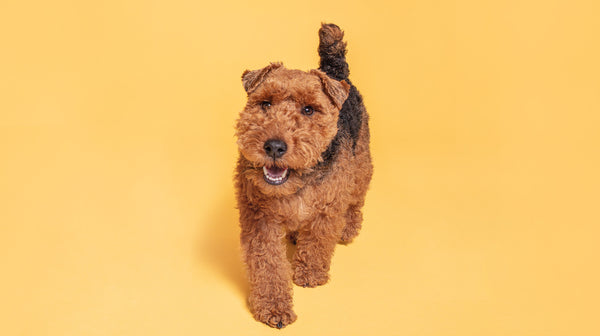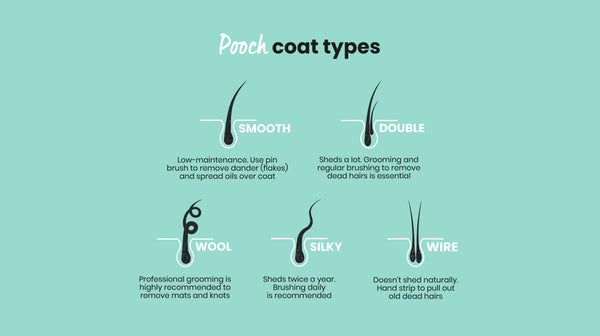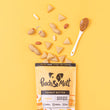FREE UK DELIVERY ON ORDERS OVER £39.99
As Crufts comes around for another year, the sight of those bright-eyed, flouncy pooches gliding across the arena may have you thinking, ‘Hmm. My dog could do with a glow-up…’
We’re sure you don’t need telling: it benefits everyone to maintain your dog’s grooming. Not only will they look and smell lovely all the time, a regular grooming routine will have them feeling light, comfortable and well-cared for.
If you’re wondering how to groom a dog at home, we’ve got you covered. By the time you’ve followed this step-by-step guide to grooming your dog, your newly fresh and fragrant pooch will be deemed best in show!
To start the pampering session, get your grooming space, tools and pooch ready.
Begin with pampering your dog’s face and then work down through the body. Your dog’s face is very sensitive, and some don’t like it when you come this close. Take regular breaks, but if your pooch snaps, gets aggressive or doesn’t seem happy throughout, it’s ok to stop and try another time.
Your dog’s eyes can be a prime area for grime and gunk to build up, usually from tears or long fur. Keep them clean by using a damp cloth to carefully wipe away grime or crusty bits. While you’re there, check for any redness or irritation - do the eyes seem clear and healthy? If not, it could be worth a vet visit or some diet tweaks (e.g.. sore eyes could indicate a vitamin A deficiency).
Next, use a damp cloth to gently wipe away grime and wax from the inner and outer ears. You can use cotton balls instead, but never use cotton buds/q-tips. It’s natural for wax to build up in a dog’s ears, but it shouldn’t smell bad, nor should it hurt your pooch to have their ears touched. If either of these things occur, take note to see a vet, as your dog could have an ear infection.
Give your dog’s nostrils a soft wipe with a clean cloth, and check that the nose is moist. A dog’s nose should be wet most of the time, except perhaps when they’re sleeping.
Brushing your dog’s teeth is all part of a regular grooming routine, so take this opportunity to work on their gums and chompers with a soft, toothbrush for dogs. We know that teeth-brushing can be a palaver for dog-owners, as many dogs infamously hate having them cleaned. Read our article on brushing your dog’s teeth for lots of advice on tooth-brushing techniques, and other smart ways to improve your dog’s dental health.

Why not treat your pooch to a mani/pedi? Some dogs don’t need their nails trimmed as walking on pavements files them down enough; but for some breeds whose claws are tougher, or for dogs who don’t walk much (older dogs, for example), cutting them could be a necessity. Generally, if you can hear your dog’s claws tapping on the ground during walks, they need clipping.
Ask your vet if cutting their nails is necessary before trying it at home. If your dog’s nails are very long, i.e. they haven’t been clipped for a long time, do not attempt to clip at home - a vet can start off this process for you.
Pooch paws see a lot of grime, and mud and dirt can get clogged between your dog’s little toe pads. Before you start nail-clipping, carefully clean between them with a wet brush and/or cloth.
Use a special nail clipper made for use on dogs, and ensure your dog is calm and comfortable. Here are some tips for clipping dogs’ nails:
Your dog is almost prepped for bath time. Make sure there’s a non-slip mat in the tub to keep your pooch from slipping, and have all your supplies within reach so you don’t have to run around at any point, leaving your dog unattended.
Before bathing, give your dog a preliminary brush out, getting rid of any tangles or particularly coarse sections of fur. If there are any stubborn matted parts, cut those out with scissors if possible. It’s important to do this before bathing your dog, as sometimes getting matted fur wet can make these sections even tougher.
Time to get wet! Ideally use a shower attachment on a bath for this, but if that isn’t available you can use a hose or jugs of water. The water should be lukewarm - not too hot or too cold.
Get your dog used to the sensation of the water, comforting them throughout. Don’t shock them with a sudden hosing but gradually soak their fur in portions, focusing on the neck down (be more gentle with water around the face and neck).
Be sure your pooch is soaked through before applying shampoo, then get your dog good and sudsy, following the instructions on the bottle. Massage into your dog’s coat, all over their body. Consider using a comb or dog brush at this time to really penetrate your dog’s fur with the product, especially if your dog’s double-coated.
Rinse with the shower or hose, being sure to get all the product out (depending on your dog’s coat thickness, this could take a while!). Avoid their face and eyes, focus on the neck down first.
When wetting your dog’s face and head, be very gentle. Use a damp cloth for sensitive areas like the eyes and mouth and do not spray water in their ears.
Next, shampoo their head by rubbing around their temples and ear flaps, gently massaging their snout and under the chin. Rinse thoroughly with water, being careful to keep product away from the eyes.
If your dog seems relaxed, repeat the above steps with any other dog bathing products you’re using (flea treatments, conditioners etc.)

Now your pooch is squeaky clean, you’re ready for styling. Remove your dog from the bathtub and into a clean space with lots of towels for drying and coat trimming.
Start by towel drying your pooch all over - easy does it. If your pooch has a thick coat, it could be worth blow drying, or using a brush or comb to get out any tangles from bathing. Keep the hairdryer on a cool setting and don’t hold the blast close to your dog’s skin or you could bother them.
Get your grooming shears and/or clippers ready, as you’re now in the role of dog stylist. It’s essential that your dog is calm during this segment, so do everything possible to keep them feeling mellow - give them fuss, dispense tasty calming dog treats, and attach a lead if necessary. Take regular breaks - and it’s ok to admit defeat if your dog just won’t play ball at this point!
Leaving the head and face until last, start trimming/clipping fur from the neck down. Starting with the back and sides of your dog is the easiest way to get them comfortable with what’s going on. Trim in the direction of hair growth in smooth movements (don’t make any sudden jolts). Remember the chest area, and carefully trim fur on the belly as your dog stands, being aware of sensitive spots.
Be very careful with paw fur. While they’re standing, guide your dog to lift each paw one at a time, and gently trim the fur between their toe pads.
Fur around the bum can be especially sensitive to trim, but it’s very important not to miss it out. Lift the tail and trim only excess fur, without getting too close to the skin. If your pooch has a long or thick coat, the aim is not to shave the area entirely but to tidy it, shortening the fur so the bum can function (!) as it should.
Leave the face and head until last, as this will likely cause your dog the most impatience. Holding your dog under the chin, use grooming shears to carefully shorten fur around their snout and mouth, and trim and shape their ears. Be especially careful around the eyes. It’s important that your dog can see clearly and doesn’t have bits of fur poking the eye area, but be very patient when near your dogs’ eyes with scissors.
When you’re done, look over your dog from different angles to be sure their new coat-cut is even, especially around the face and ears. Give your dog a soothing massage in their fresh fur, and a final calming dog treat, completing the pampering session.
Add cute accessories like a bow tie or hair ribbon as desired, and your prim and princely pooch is good to go.
Before you get into Crufts mode and grab the shampoo for dogs, be sure to bear in mind the following:
Some of you may be thinking, ‘But my dog has an unusual coat?’. It’s true, grooming techniques and frequency is very dependent on what kind of coat your dog has. Your vet can give you more specifics, but here’s a quick reference guide to grooming for different coats:

Dogs with very short or smooth coats need the least amount of grooming, but it’s still important to keep them clean. A weekly brushing session should be adequate, with regular bathing and scheduled grooming every couple of months.
Keep your medium-coated dog smooth and fresh by brushing them every few days and bathing when needed (after muddy walks, etc). Be sure to keep their coat trimmed, especially in the summer.
Long-haired dogs require daily brushing to keep tangles and knots out. When it comes to grooming, conditioning and styling is important so their fur is kept out of their face and they can get around easily. Consider shortening their coat in the summer so they stay cool.
Double-coated dogs require more maintenance, as they shed regularly and their coats are important to how their bodies function. Use a special undercoat comb to regularly brush them, and pick a shampoo formulated for double-coated dogs. Be sure to always dry them properly after bathing to prevent skin issues.
Regular brushing is needed with curly breeds in order to avoid tangles and distribute natural oils through the fur. Owners of curly breeds often use professional groomers who are specially trained in cutting curly fur.
Wire coated breeds require specific grooming techniques to keep the quality of their coarse fur. This sometimes involves using a handstrip or strip knife to get rid of rogue hairs, though some dog owners clip the whole coat uniformly. Chat with your vet or a professional groomer to consider options.
If your dog isn’t the most co-operative around grooming time, it could be worth going the extra mile to make it a positive experience.
Grooming at home saves money but it’s also a big effort, and lots of pooch parents choose to use the services of a professional groomer. This can be especially beneficial if:
Clipping a dog’s nails at home can be nerve-wracking and accidents can happen. If you’ve trimmed the nail back too far and hit the ‘quick’ (blood vessels and nerve endings within the claw), your dog’s nail might bleed.
Stay calm (your dog will pick up on your distress if you panic), dip the nail in some styptic powder (an anti-hemorrhagic agent that stops light wounds from bleeding) and apply a cotton swab. These things happen and the snip will usually heal relatively quickly. If your dog seems in pain and it continues to bleed, get in touch with your vet.
Grooming needs to be a regular part of your dog’s schedule. It depends on your dog’s particular coat and how often they get dirty (!) but in general, a full groom every four to six weeks is recommended.
Your dog may need grooming more often in the summer, especially if they have a long coat that makes them overly hot. Small grooming tasks can be done much more regularly - for instance, brushing your dog, bathing them after muddy walks, or cleaning their eyes and ears.
It can be very frustrating trying to groom a difficult dog. Keeping a calm space, as well as grounding them with calming dog treats, praise and affection will give them a sense of safety. Also, the more regularly they’re groomed, the more they will get used to the process and hopefully become more mellow with time.
However, if your dog simply won’t let you groom them - if they snap or go into attack mode, or they seem distressed by the whole ordeal - consider going to a professional groomer or behavioural therapist instead. Your vet can give some recommendations on what to do next so your dog can be clean and coiffed, but happy, too.
To groom your dog into a Crufts condition, stock up on calming dog treats or grain-free dog food first to have them feeling their most serene. Our calming dog food is packed with natural relaxants such as hemp and chamomile to soothe your dog while benefiting their body and mind.





Never miss a treat!
Subscribe to our newsletter and get blog articles amongst other treats delivered to your inbox





Comments (0)
Leave a comment